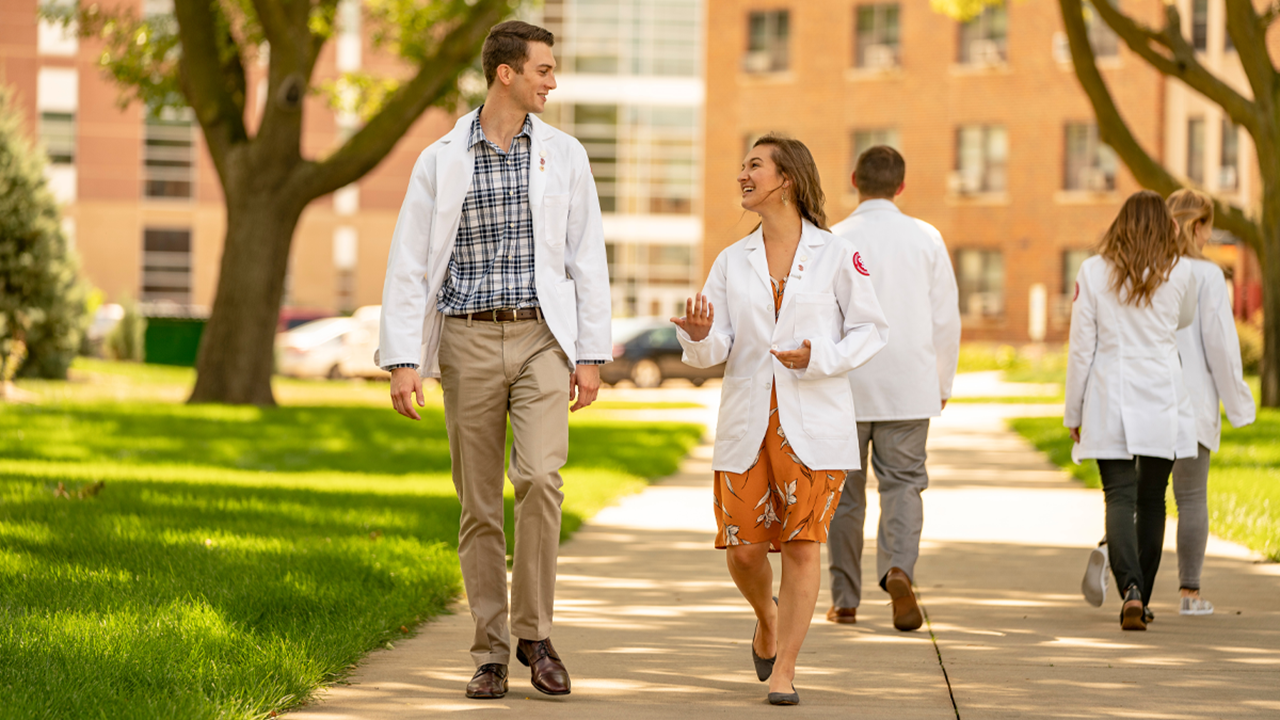The Foundation of a Physician

That seems to be the case for the earliest courses of medical school, the part of the curriculum now known as the basic biomedical sciences. The factors for this are evident. Nearly all the basic sciences are presented in several classrooms and labs in the Lee Med building on the main USD campus in Vermillion. And so all incoming first-year students go through this portion of their training together. Students have progressed from successfully navigating their undergraduate studies, and they soon discover the academic demands of medical school are markedly complex.
1998 graduate Dr. Lisa Brown said this about her experiences in the basic sciences: “The density of the information was heavy.” Dr. Lee Bailey, Class of 2000, used a more vivid description to describe the intimidating volume of information a student faces and must process during that part of their training: “It’s like trying to take a sip of water from a gushing fire hose.”
A small-sized medical school like the Sanford School of Medicine offers a closeness of students and faculty, as well as a sense that the students are moving through their training together, enjoying learning and managing the challenges, not only as individuals but as a group. This amplifies the
emotions and satisfactions associated with this important part of a physician’s career.
The Sanford School of Medicine has been subjected, by choice, to several high-level curriculum transformations during its existence, and each dramatically impacted the basic sciences portion of the curriculum. For its first 68 years the medical school was a two-year institution, with a curriculum focused on the basic sciences and preparation for the final two years of medical school to be completed at a different institution. By all accounts, USD medical students did very well
at those other institutions, with many graduates reporting that the thoroughness and depth of courses at the school of medicine provided a scientific framework for the clinical portion of medical school.
The second transformation was the revamping of the entire curriculum – including the basic sciences – starting in 2013. In that year, the school changed from being a traditional four-year program to one designed around three “pillars.” Pillar 1 is the pre-clinical portion of the curriculum that contains the basic sciences. This pillar establishes a strong foundation for each student during a very focused 18 months – three semesters – of integrated basic science courses. The previous
curriculum presented the basic sciences during a two-year timeframe.
During Pillar 1, students are taught anatomy, biochemistry, physiology, microbiology, immunology, pathology and pharmacology interwoven into blocks. Course titles don’t roll off the tongue with any sort of rhythm or poetic cadence. Instead, they confront like boulders in a stream, and they remind each student of the no-nonsense business at hand. Consider these course names: Medical Foundations 1 and 2. Foundations of Clinical Medicine 1 and 2 and 3. There’s Skin and Musculoskeletal. Nervous System. Blood/Hemo/Lymphatic. GI and Hepatobiliary. Cardiovascular. Respiratory System. Renal and Urinary System. Endocrine & Reproductive. Physical Diagnosis.
“We integrate the basic sciences to what students will see in clinics and in their future practices,” said William Mayhan, Ph.D., dean of the medical school’s Division of Basic Biomedical Sciences. That strategy, added Mayhan, reinforces the school’s overall strategy to prepare its students for real-world clinical conditions. “We teach our students the scientific method of inquiry,” he explained. “They learn how to ask questions, how to gather data, how to formulate a hypothesis, and that leads to making a clinical diagnosis. Our students become clinical scientists.”
The gross anatomy lab is one component of the basic sciences that generates a disproportionate amount of student and graduate recollections. Those who taught the lab, the subject matter, the detailed and fascinating work on cadavers – these factors blend or stand alone to create vivid, indelible memories for many students.
There were gross anatomy lab instructors like Dr. George Rinker, with a grand reputation for kindness and blackboard artistry. Or Dr. Harry Settles, remembered for his genuine interest in his students, and for his gentrified attire.
Graduates remember the distinct smells of the anatomy lab, though that aspect has changed and vastly improved with the evolution of facilities and ventilation. They remember the reverence and the gratitude they felt while working on a donated body.
In more recent years, in addition to working on cadavers, students use plastinated body parts, 3-D virtual dissection and a novel whole-body cadaver for study and learning. Plastinated sections are real body parts encased in plastic. Introduced in 1977, the plastination process replaces the water and lipids in biological tissues by curable polymers, mostly silicone, epoxy and polyester, which harden and result in natural looking, dry, odorless and durable specimens. There are many applications of this process, including in medical school education, and the materials used in the process are safe and hazardless. 3-D animation allows students to rotate virtual cadavers to obtain a view of the structural relationships between organ systems. The whole body prepared cadaver allows students to visualize a “perfect” dissection of the human body.
Research indicates students learn and retain basic science knowledge better when they can apply it to patient care early in their education. The shortened basic sciences portion of medical school coupled with opportunities to participate in regular clinical care and simulated experiences and cases sooner in one’s training are the result of that approach.
According to the medical school’s 2020 graduates, the quality of their basic sciences training was outstanding. Compared to same-year graduates of other medical schools in the nation, the basic sciences preparation at Sanford School of Medicine ranked above the 90th percentile. Over the past three years the relevance of the basic sciences curriculum at the school of medicine ranks in the 90th percentile nationally. “Clearly,” said medical school dean Dr. Tim Ridgway, “our basic sciences education is succeeding and doing very well.”
